 34 Reasons I Love Yucatan – Mexico
34 Reasons I Love Yucatan – Mexico
When I set out on my first explorations of Central America last November, I was very excited about Guatemala and Belize. But I didn’t know what to expect from Mexico. I ran out of time to research, so I had no knowledge of particular destinations or things to see and do.
Having grown up in the US, my only notion about Mexico was that it was a rather dangerous, developing country. On the other hand, recent perspectives from several travel blogging friends all reported a completely different picture – of a safe country full of beautiful places and interesting things to do. So my expectations were mixed.
When I finally arrived in Mexico in late January this year, I had no idea I was about to be blown away by one of the best places I’ve explored in all my 18 years of world travels – Yucatan Peninsula.
I had intended to spend one month there, but ended up staying three months…and then returning again in June for an indefinite period of time.
Clearly an article about Yucatan was in order. I sat down to write up a list of all the things I love about Yucatan and I quickly amassed a whopping 30+ items without any effort. In contrast, my usual country list reaches 10-15 points, and that after putting some thought into it.
That alone should hint at how great Yucatan Peninsula is. So, without further delay, allow me to fill you in on the peninsula’s many charms…
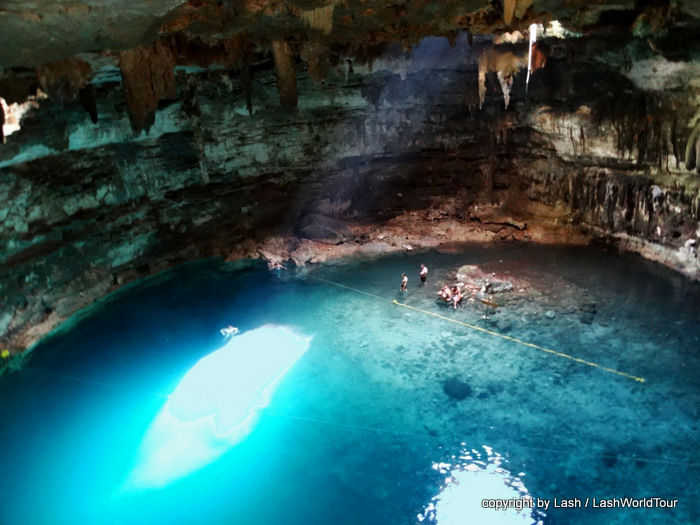 1. Cenotes
1. Cenotes
Yucatan Peninsula is essentially a massive limestone plateau. And limestone is full of air holes, something like Swiss cheese. Yucatan’s underground water table is extremely shallow, lying only 2-30 M below the Earth’s surface.
This mass of flowing water rushes through underground rivers, holes and caves. Such holes and caves filled with water are known as cenotes. More than 3000 cenotes are scattered around Yucatan Peninsula.
In many places the Earth’s thin crust has broken through to reveal the water holes below. Sometimes only a small opening appears, like a window into the under world. In other places the entire water hole is exposed to sky.
Cenotes vary greatly in size, amount of sunlight, depth and vegetation. Some have waterfalls cascading down from the surface.
But cenotes also have some things in common: cold water, incredibly beautiful blue colors and below-surface water pools.
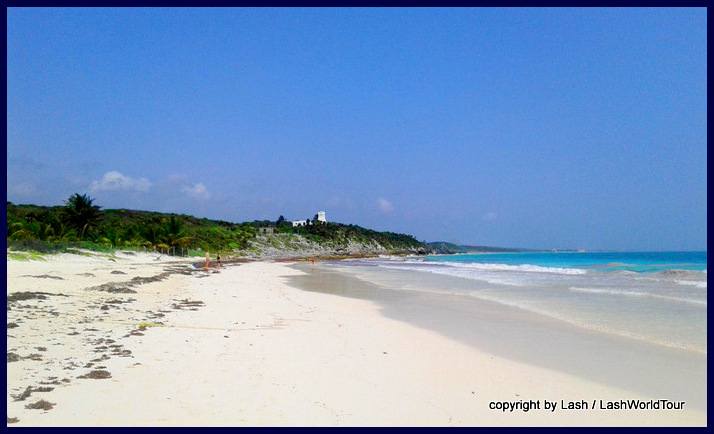
north end of Tulum Beach – Mexico
2. Powdery-white beaches
Yucatan’s 400+ km (240 miles) of Caribbean coastline consists of a series of long gorgeous beaches. From Cancun at Yucatan’s far northern point all the way down to Chetumal city, near the border of Belize, stunning beaches line the gorgeous Caribbean waters.
Some beaches, like Cancun and Playa del Carmen, are highly developed tourist destinations, backed entirely by big resorts a la Hawaii’s Waikikii.
Other beaches, such as Tulum, are preserved in a much more natural state, backed solely by dunes, forests and eco-friendly hotels that blend into nature. Yet other beaches are completely undeveloped – left in an entirely wild state with no amenities at all.
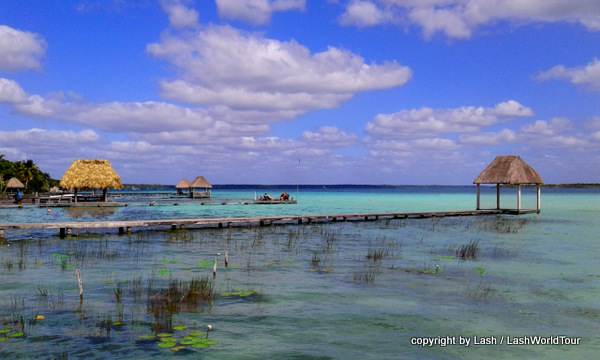
Laguna Bacalar
3. Amazing water colors
The Caribbean Sea along the Peninsula exhibits incredible shades of aquamarine, teal, turquoise and deep blue waters.
Likewise, Yucatan’s numerous lakes, lagoons and cenotes also glisten with breath-taking water colors.
4. The Meso-American Barrier Reef
The Meso-American Barrier Reef is the second largest in the world, just after Australia’s Great Barrier Reef. Extending for 700 miles, it’s also the largest reef in the Americas.
The gorgeous UNESCO World Heritage Site begins at the northern tip of Yucatan Peninsula and runs along the entire coastlines of Yucatan, Belize, Guatemala and into Honduras, where it ends at Utila and Roatan Islands.
Needless to say, Yucatan has amazing diving and snorkeling sites along its entire eastern coast. Cozumel Island is particularly spectacular, with deep walls, strong currents and an astounding variety of sea life and corals.
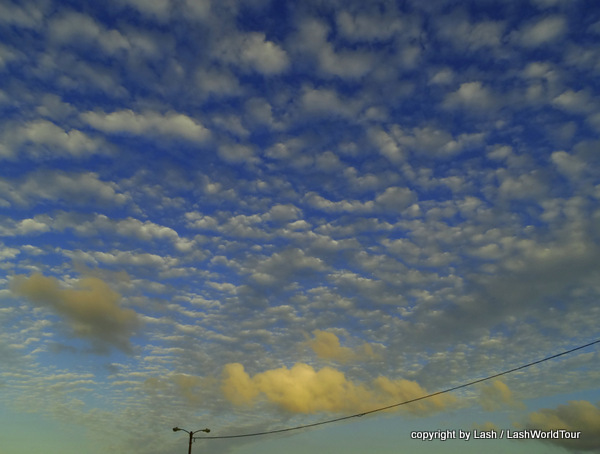
incredible sky near Chetumal
5. Gorgeous skies
Not to be outdone by Yucatan’s amazing water colors, the sky over Mexico is incredibly clear, clean and vibrant blue. It’s often punctuated by white fluffy clouds which change greatly from day to day, even hour by hour.
I’m not sure why Mexico’s sky is so distinctly vibrant – perhaps a lack of pollution, industry and high population?
6. Fabulous climate
Mexico is a big country with an extremely varied topography. Like the US, climates vary from region to region.
Yucatan Peninsula tends towards a tropical hot and humid climate, very similar to SE Asia. But it’s more comfortable than SE Asia most of the year because it’s considerably drier.
Along Yucatan’s extensive coastlines and islands, sea breezes cool things down. Winters can get chilly, which makes a great change of pace a few months of the year. Come to think of it, Yucatan’s weather is just like Florida’s. Love it or hate it.
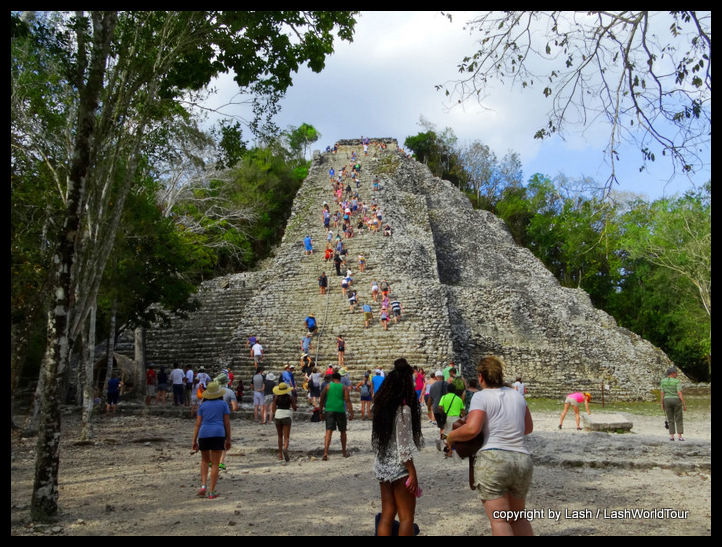
Coba Mayan pyramid
7. Mayan ruins
The area now known as Yucatan, along with Belize and Guatemala, was the main stronghold of the ancient Mayan civilizations. Yucatan is now home to several of the most extensive and important Mayan ruins.
In addition to several famous Mayan temples, dozens of smaller, less spectacular ruins are scattered all over Yucatan. They’re all set in tranquil forests, so they make great outdoor excursions from various towns around the peninsula.
8. Low population density
Very few places in Yucatan feel crowded. Only a few major tourist cities, like Cancun and Playa del Carmen, and primary tourist attractions, like Chi Chi Itzen Mayan ruins and Cozumel Island, are jammed with people.
Just about everywhere else looks and feels practically devoid of people. And that is A-ok with me.
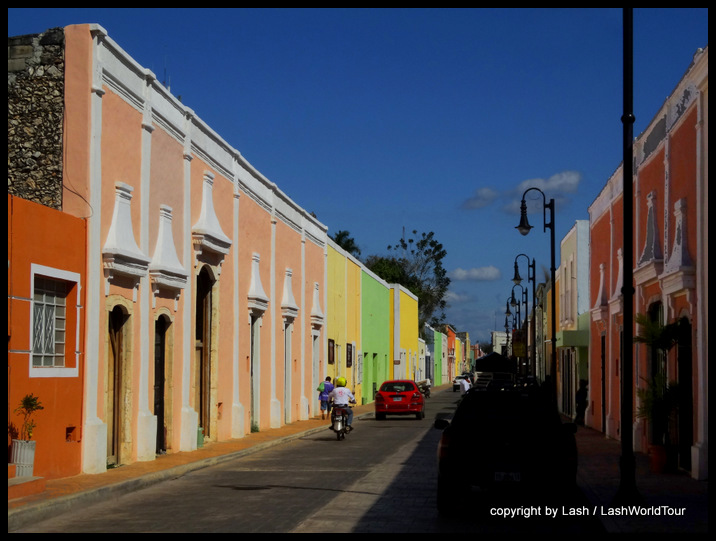 9. Historic colonies cities
9. Historic colonies cities
Like most of Central and South America, Mexico was colonized by the Spanish from the 1500s through the 1800s. The conquerors built many beautiful cities and towns centered around one large main plaza flanked by a towering church or cathedral and lined by imposing government buildings.
From there streets radiate out in a grid-pattern, lined by shops, restaurants, bars, hotels and other businesses housed in beautiful colonial buildings.
In Yucatan, many historic Spanish colonial cities and towns have been preserved and restored. Valladolid, Merida and Campeche are the most impressive and well-known.
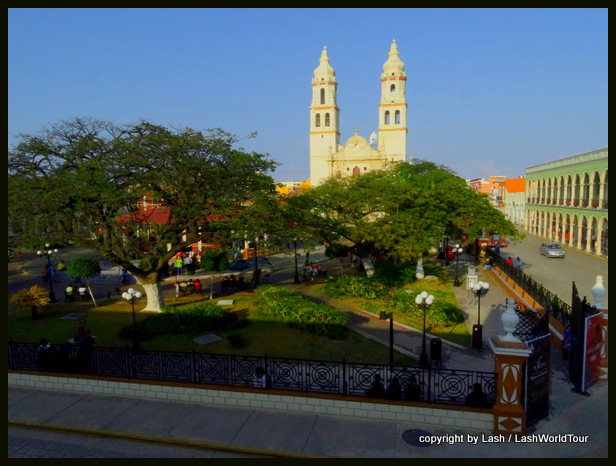
Campeche cathedral & plaza
10. Town plazas
As I mentioned, Mexico’s Spanish conquerors constructed their towns and cities around a main town plaza. These large leafy plazas provide a spot of nature, much-wanted shade, a place to socialize, people-watch or enjoy a snack from a local street vendor.
On weekends the main plazas often feature craft, clothing or food markets and free entertainment such as dance orchestras or traditional performances. Throughout the year, various festivals are also set up at town and city plazas. They range from small local events to large national celebrations. I love how all these free public events are offered to residents and visitors and how many people participate in them. They’re really fun
Larger cities like Merida, Valladolid and Campeche, have several other small plazas scattered around. Like the main plaza, they are great local gathering spots and are often lined by beautiful architecture.
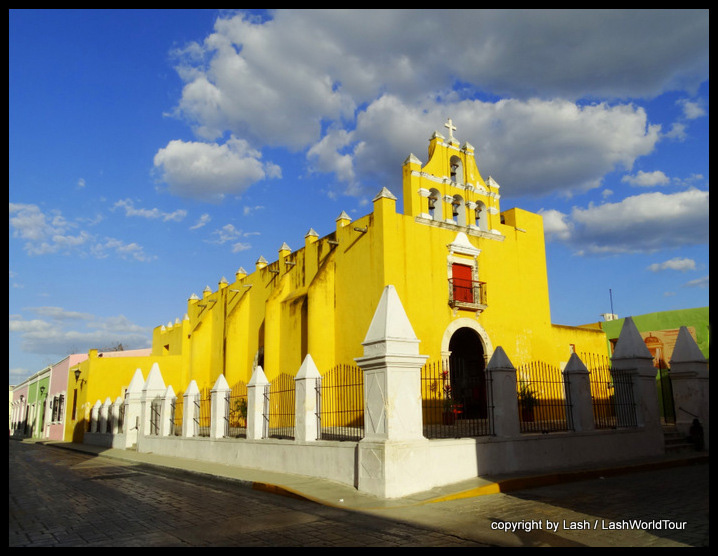
Historic church in Campeche
11. Historic Catholic churches & cathedrals
The Spanish seemingly had a fervor for building churches and cathedrals. Most Yucatan towns have a dozen or more churches of various sizes, designs and levels of elaborateness. Interior architectural detailing, statuary, stained-glass windows and other religious garnishing vary in splendor from church to church.
Most are still functioning churches today. Attending a Sunday mass in Mexico is a very interesting activity. There you’ll witness the Mexican or Mayan version of Catholic sermons, often complete with a live guitar band.
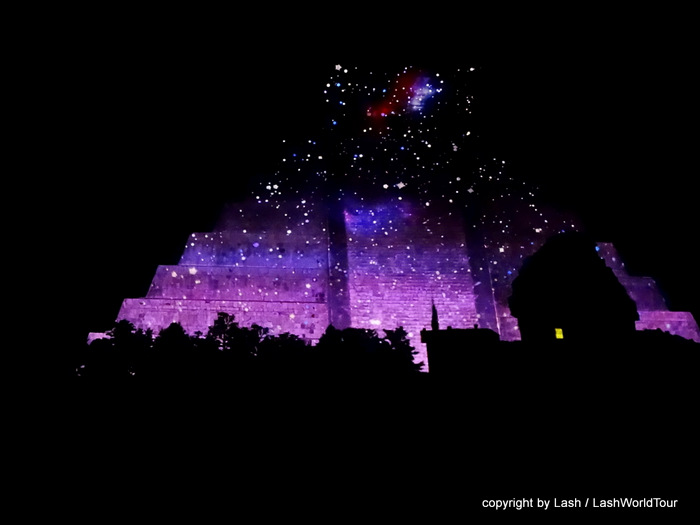
Night video show at Chi Chit Itzen
12. Amazing video light shows at monasteries and Mayan ruins
I witnessed my first Mexican video light show projected onto the massive stone walls of San Bernadino Church in Valladolid. I was astounded. Impressed by the professional quality, creativity and presentation.
I figured that show was a one-off, until I saw other equally-impressive video shows projected on buildings in Campeche city and onto the main temples of Chi Chi Itzen Mayan ruins.
Mexicans do video shows incredible well.
13. Sunday evening public dancing & markets
On Sunday evenings in many Mexican towns and cities, people gather at the main plaza to enjoy free traditional dance orchestras, outdoor public dancing, street vendors, socializing and people watching.
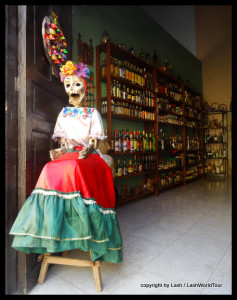
Skeleton mascot at a tequila shop in Valladolid – Yucatan
14. Skulls & Skeletons
Skulls and skeletons are a very common motif all over Mexico. They originate from long-standing Mexican traditions centered around Dia de los Muertos / Day of the Dead festival, which takes places annually in early November. As a result, skulls and skeletons are prevalent in Mexican paintings, murals and decore.
In the tourist industry they’ve become one of the most prevalent designs, decorating everything from T-shirts to coffee mugs & wine glasses to small figurines to jewelry and much more.
My favorite skeleton I’ve seen to date is this life-size tequila shop mascot in Valladolid.
15. Dark roast coffees/espressos
I was surprised to learn that Mexico grows and produces a huge quantity of high quality Arabic coffee. Even better, they make some delicious dark roasts for espressos. Even better still, gourmet Mexican coffees are sold in super markets at very low prices.
This contrasts greatly with neighboring Belize and Guatemala who both produce quality coffees, but very few dark roasts. While traveling through those two countries I had an extremely hard time finding dark roast coffee. But in Mexico it’s very easy to enjoy my preferred roasts, and at super low prices.
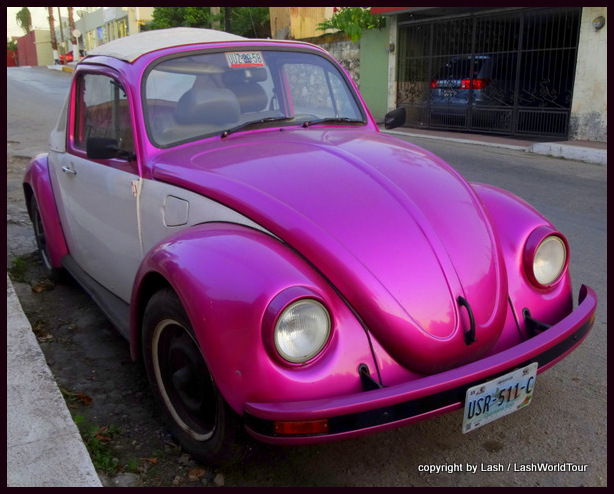 16. VW Beetles!
16. VW Beetles!
When I arrived in Yucatan in January, 2016, I was quite surprised to see VW Beetles driving around. Soon I started noticing them everywhere. I saw so many Beetles, of all colors and condition, that I started asking questions. Primarily, why so many Beetles?
Turns out that Mexico has long been a major manufacturer for VW. Mexican factories were making Beetles all the way up through the 1990s.
Today thousands of those ultra-cute cars are still driving around Mexico. Yippie!
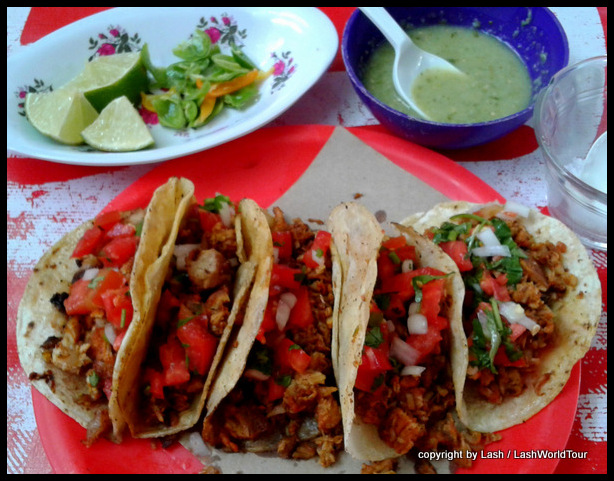
pork tacos in Campeche
17. Typical Mexican/Yucatan foods
Authentic Mexican food like tacos, quesadillas, tamales and burritos here in Mexico are considerably different from their American counterparts.
Not surprisingly, a whole slew of other Mexican foods not found in the US are also common here. Tortas, sopas, panuchos, salbutes, empenadas and ceviche are a few dishes up for grabs among the extensive range of little-known Mexican meals.
I’m slowly eating my way through all the new-to-me dishes. They’re all quite tasty. My only gripe is that Mexican cuisine is disappointingly low on vegetables.

paletas – frozen fruit bars i
18. Paletas – Frozen fruit bars
Local shops selling frozen fruit bars are as common as ice-cream or gelato shops in other parts of the world. Paleta parlors generally offer 10-20 amazing tropical flavors including coconut, tamarind, pineapple with chilies, lemon, watermelon and some exotic fruits native to Mexico.
In Yucatan’s hot climate paletas are extremely refreshing and healthy snack.
19. Fresh tamarind juice
I’ve been a huge fan of tamarind ever since I first tasted that tart, sticky fruit in Thailand back in the 1990s. During my 16+ years of travels around SE Asia I regularly ate tamarind in various forms – fresh fruit off the trees, dried and sugared tamarind candies, tamarind cooked in regional cuisines.
So in Mexico I was delighted to discover that fresh tamarind juice is a popular, common beverage, sold at most local eateries.
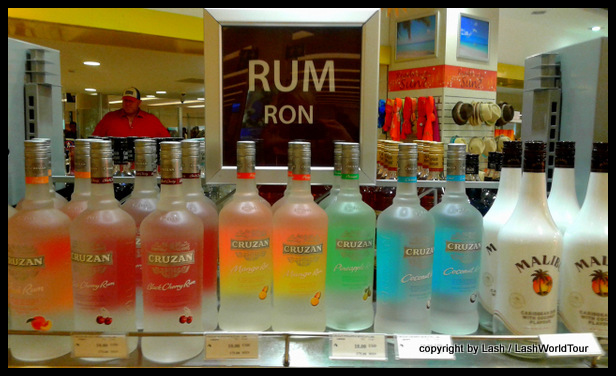 20. Cheap rum – aka ‘ron’
20. Cheap rum – aka ‘ron’
Rum originated in the Caribbean, particularly in Cuba and Puerto Rico. So in Mexico, Rons from neighboring countries as well as domestic Rons are very, very inexpensive.
For example, I recently bought 1 Liter of Bacardi Superior White Rum for 120 ps / $6.67 US ! In the States that costs about $18-20 US.
But Bacardi is one of the MORE expensive rons here.
This week I bought 1 Liter of Baraima Ron for 65 ps / $3 US !
Sure, it’s not as smooth as Bacardi or other top shelf rums, but it’s still quite good…and mixed up in Mojitos with mint, lime and sugar, Baraima tastes just fine.
Here in Yucatan I’ve been drinking large glasses of mojitos for about 20 ps per glass / $1.10 US
Yippie for inexpensive spirits in Mexico!
21. Popcorn
Popcorn has always been one of my favorite snacks. In SE Asia, it’s generally rather hard to come by. So after spending nearly 16 years of my life in SE Asia, finding popcorn is always a great treat.
Quite happily for me, in Mexico popcorn is a very common snack, sold at street vendors in most towns and cities. And it’s generally very well made. A small bag costs 5-10 ps / $0.30-0.60 US
Cinemas also sell popcorn, just like in the US. Nothing better than popcorn and a coke while watching a movie.
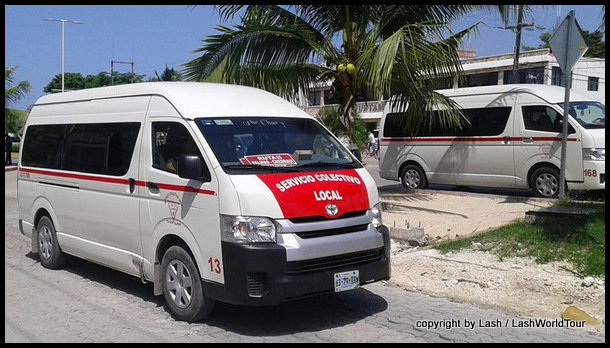
collectivo in Tulum – Mexico
22. Great public transportation / overland buses & colectivos
Mexico’s long distance buses are some of the most luxurious I’ve come across in 18 years of world travels, particularly buses from Mexico’s ADO company.
ADO has the only buses outside the US that I’ve come across that have toilets inside. That makes long-distance bus travel much easier, for me at least.
Besides full-size buses, there are also colectivos – aka combis – that transport people within cities and over land. Colectivos are vans that are used like local buses, picking up and dropping passengers off as they proceed along their routes. Combis are generally much cheaper than buses and take about the same time.
Taxis are also often used as colectivos, whereby several passengers share one taxi to a particular destination, often from one city to another. Taxi-combis work well in areas where few buses or colectivos operate.
With all these overland options, getting around Mexico is fast, easy and usually quite affordable.
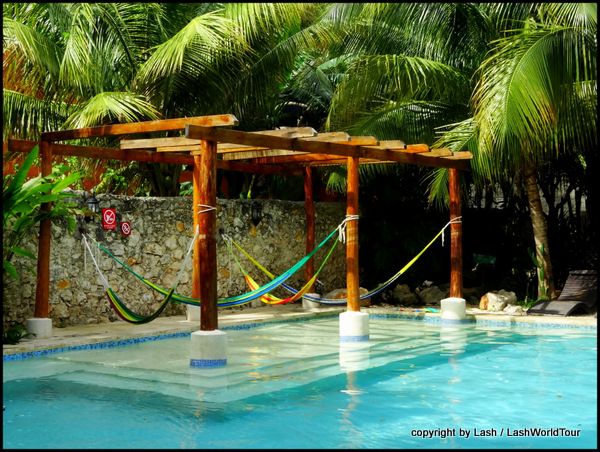
swimming pool at a Mexican hostel
23. Fabulous hostels and guest houses
I’ve never been a fan of hostels and dormitory living. Even when traveling in my 20s I always searched for private rooms rather than dorms. I much prefer privacy and quiet, not communal living.
Mexico is the only country in my travels thus far where I’ve found that dorm life is not so bad. It’s all about space.
Most hostels I’ve stayed at around Yucatan have been housed in big colonial houses and buildings. The rooms are huge, the ceilings very high, and the beds spread out with plenty of space between them.
Many hostels also feature beautiful architectural detailing, cool interiors, art, courtyards and/or gardens. One I visited has a swimming pool set in a garden surrounded by historic stone walls. One offers free Salsa, yoga and cooking lessons. Several have shady gardens and great sitting spaces.
Mexicos hostels/backpackers are more like staying in flashy B&Bs.
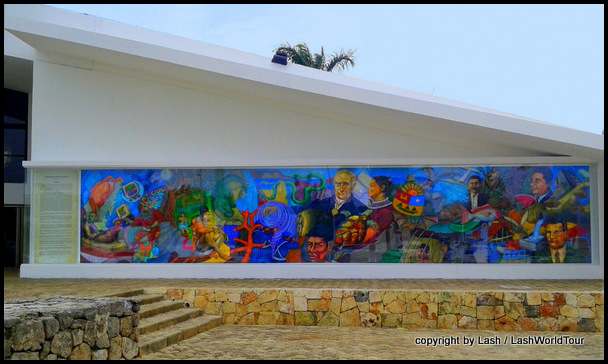
famous mural in Chetumal
24. Art, galleries, art cafes and large murals
Mexico has always had a thriving, colorful and diverse art scene.
Huge, wall-size murals are one particularly popular painting form found in most towns and cities. Huge vibrant graffiti paintings adorn building exteriors. But many government buildings also feature extravagant murals by famous Mexican artists inside lobbies of public government buildings.
25. Cinemas
Traveling around Mexico’s neighboring countries of Central America, such as Guatemala, Belize, Honduras and El Salvador, you’ll be hard-pressed to find a modern cinema. Not so in more-developed Mexico.
Giant multi-plex cinemas are found in most towns and cities of Yucatan, generally at large shopping malsl. It’s a huge treat for long-term travelers like me to go watch a film on a large-screen cinema hall, catch up on the latest movies and maybe munch on some popcorn and coke.
Even better, movies cost only about 40 ps / $2.20 US!
 26. Availability of luxury goods / high-quality goods
26. Availability of luxury goods / high-quality goods
Anyone visiting Yucatan from North America or Europe probably won’t make note of the region’s shopping malls, cinemas, designer boutiques, upscale restaurants & resorts and luxury merchandise on offer in cities around the peninsula. That’s all part of normal life in 1st world countries.
But for travelers arriving from other Central American countries, Mexico is a modern wonder. In Belize, Guatemala, Honduras or El Salvador, you’d be hard-pressed to find luxurious goods like Lindt chocolate, Starbucks espresso, designer sunglasses or even a modern cinema.
And while I love exploring less-developed countries, getting immersed in traditional cultures and roughing it on less-than-ideal roads, I also appreciate being able to enjoy a few favorite modern luxuries. For that, Mexico is a wonderful destination in this region of the world.
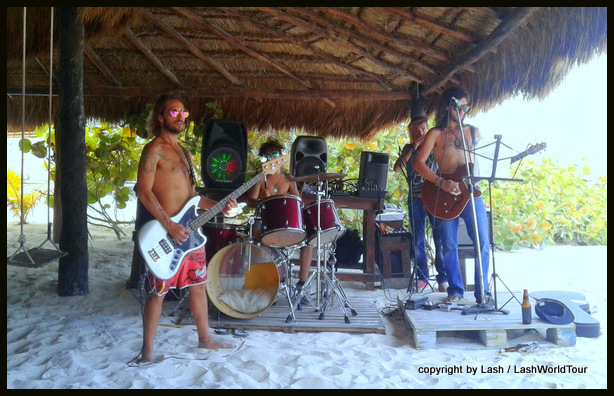
live rock band at Tulum Beach bar
27. Great live music / bands
Though I never knew it, Mexico has a very diverse and well-established music culture. Ranging from traditional music bands like Marachii, Salsa and folkloric groups through to modern pop, retro rock and many forms of alternative music.
In Mexico I’ve been delighted to finally escape the typical invasive western pop and exhaustively over-played 80s American soft rock.
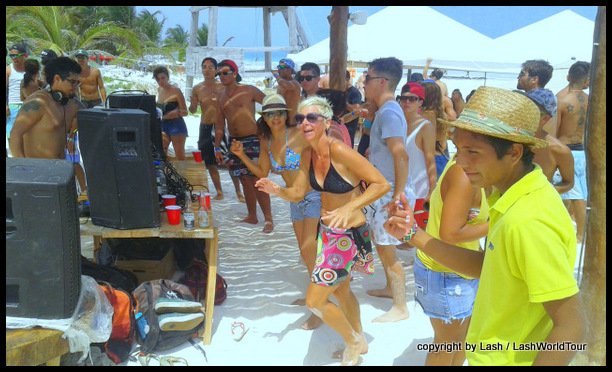
dancing at a Sunday rave party on Tulum Beach
28. Raves
Trance and other electronic music parties are alive and well in Mexico. Ravers gather at amazing outdoor venues like cenotes and beaches to dance the night away with fire-spinners, jugglers and well-seasoned djs. That’s my kind of scene!
29. Laid-back tranquil pace of life / people
Like all other tropical places I’ve explored, Yucatan has a very laid-back, unhurried vibe and pace of life. Nothing feels rushed and few people burden themselves with chasing the all-mighty-dollar. No high-pressure American-style workaholics here in Yucatan.
People take time to visit beaches, spend time with family and friends, hang out in city parks and regularly join events, markets and performances.
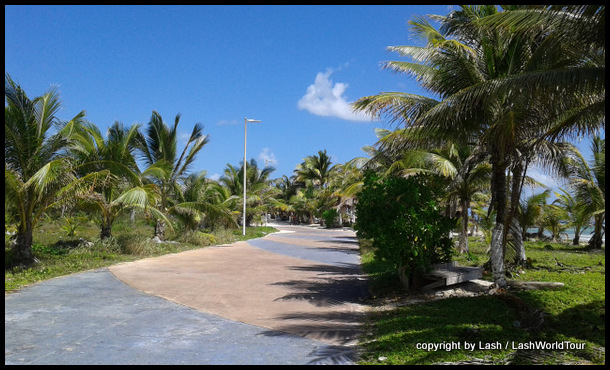
malecon at Mahahual – Yucatan
30. Malecons
Malecons are seaside pedestrian walkways. Most beaches and seaside towns in Yucatan feature a long, wide malecon extending for several miles, either backing a powdery-white beach, like at Mahehual, or along a rocky shoreline, such as at Campeche city.
Both locals and tourists enjoy malecons, especially in mornings and evenings. Locals go jogging, cycling, strolling and socializing. Tourists take in the sea views and local happenings.
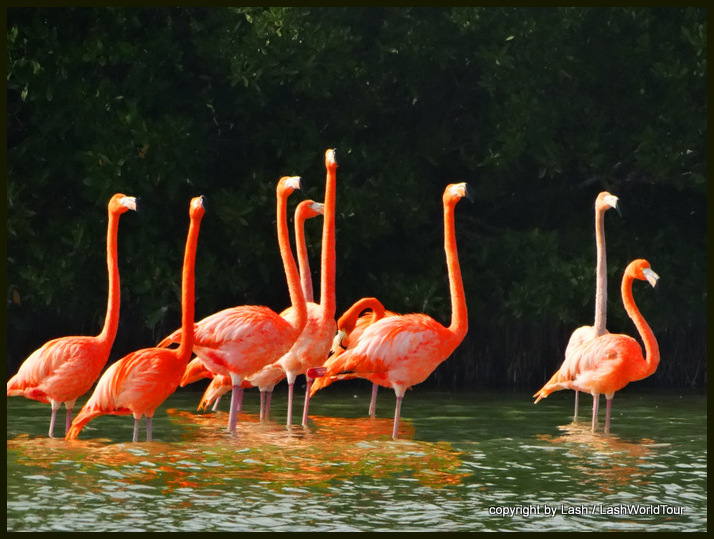
pink flamingos at Rio Lagartos – Yucatan
31. Pink Flamingos
Rio Lagartos and Celestun are famous for their huge flocks of pink flamingos. I’m talking hundreds of birds gathered to feed, breed and nest.
Both of these small fishing towns are located on Yucatan’s northern coast along the Gulf of Mexico. Local boatmen take tourists out along mangrove-lined rivers and estuaries to witness the rare site of these unique tropical water birds.
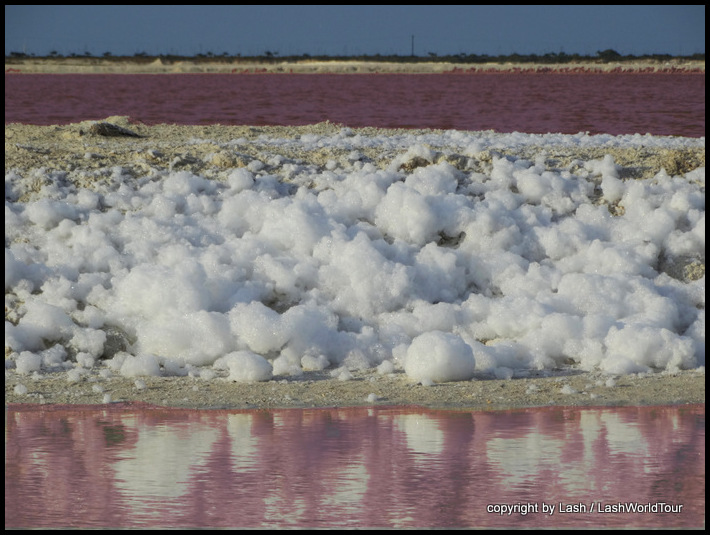
naturally pink water and saline foam at Rio Lagartos
32. Naturally pink water at Rio Lagartos
Who ever heard of pink water?! I certainly never had. Until I visited Rio Lagartos, which is actually more famous for its huge flocks of pink Flamingos.
Near Rio Lagartos is a large salt manufacturing plant. They’ve created a series of shallow canals to help make salt via evaporation. Sea water in the shallow canals becomes extremely saline. A microscopic organism favors those super salty waters. The tiny animals somehow turn the water lovely shades of pink. Crazy!
33. Safety
In great contrast to what I’d been told about Mexico being a very dangerous country, I’ve discovered that Yucatan is actually a very safe place. As safe as Asian countries I’ve explored in depth.
I’ve walked Yucatan’s city streets alone at night, cycled solo into remote countryside, taken crowded colectivos and slept in dorm rooms with no locks on the doors.
Naturally, I’ve asked locals about my safety before heading out on any of those excursions. And in every city & town they’ve told me it’s safe. And it has been. I’ve never felt the least threat to either myself or my possessions.
Now I’m sure there must be some dangerous places in Mexico – just like there are dangerous places in the US – but Yucatan Peninsula is not one of them. Even Mexicans consider Yucatan one of the country’s safest areas.
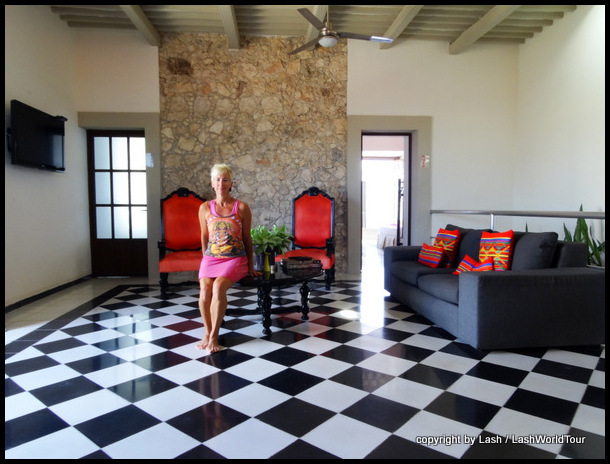 34. Diversity
34. Diversity
As you can see, Yucatan is an incredibly diverse place. There’s always somewhere beautiful to visit and interesting, fun activities to to.
If I want to immerse myself in nature, I can choose between stunning beaches, cenotes, lagunas, mangrove rivers, coral reefs, forests or jungles. I can hike, stroll beaches, swim, snorkel, go bird watching, scuba dive or ride a rental bike.
On days I feel more culturally inclined, I can visit Mayan ruins, historic colonial towns, museums & art galleries or watch exciting traditional performances.
If I’m yearning for a bit of modern life or luxury, I can head to Playa del Carmen, a cinema, boutique stores or an upscale resort for the day.
And that makes Yucatan a wonderful place to spend a lot of time.
———————————————————————————-
You might also enjoy:
My First Impressions of Mexico
—————————————————————————————————————————-

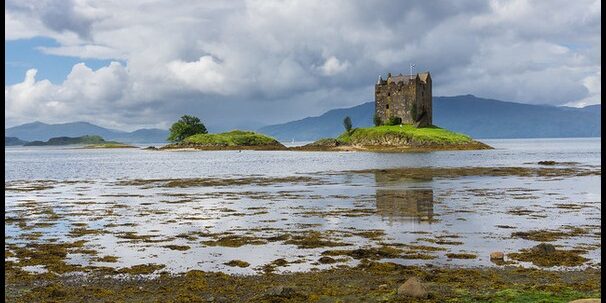


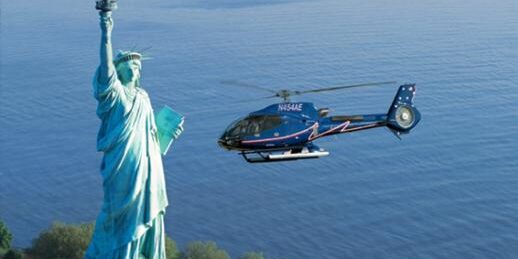


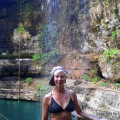

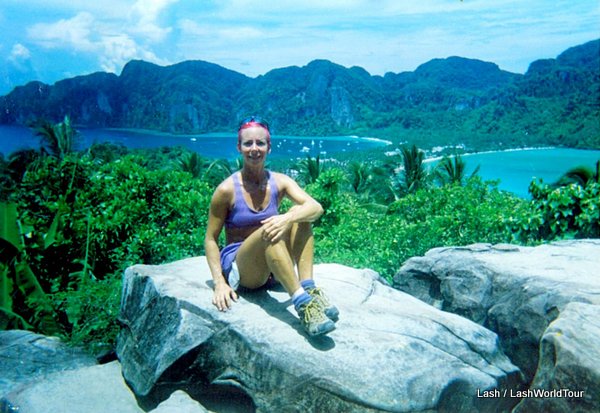


 Hi! I'm Lash, an American nomadic world traveler who's been traveling solo since 1998. I’m passionate about traveling the world nomadically and then sharing it all with you. I hope to inspire you to travel the world, to entertain you with tales from the road, and to help you reach your travel dreams. Welcome!
Hi! I'm Lash, an American nomadic world traveler who's been traveling solo since 1998. I’m passionate about traveling the world nomadically and then sharing it all with you. I hope to inspire you to travel the world, to entertain you with tales from the road, and to help you reach your travel dreams. Welcome! 




1 ping